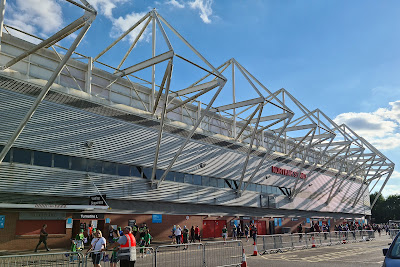On the 7th July I went to my first ever football match. Many members of my family have been regular supporters of our local team, and others, over generations but I am not a fan of ball sports preferring those with wheels and often engines too. However, the Women’s Euros are on, and a number of matches have been hosted at St Mary’s Stadium, the Southampton FC ground so I decided to go with my Mum and sister to see what all the fuss is about.
 |
| St Mary’s Stadium. Image credit: Louise Dennis. |
The match was Norway vs Northern Ireland and despite the stadium being a third full the atmosphere was fantastic not least because the ‘Green and White Army’ supporters were full of excitement that the Northern Ireland team were playing their first ever match in a major tournament.

The Northern Ireland supporters. Image credit: Louise Dennis.
Of course, as Curator
of MoDiP I felt it my duty to do some ‘plastics spotting’ whilst I was there. The first thing that struck me was the sea of
red stadium seating. (I explored stadium
seating in a previous blog post which I wrote after enjoying the Le Mans 24hourrace).

A panoramic view of a sea of red stadium seats. Image credit: Louise Dennis.
This time instead of fixed seat pads, the stadium is filled with flip up seats which are made up of a separate seat pad and back rest mounted on a spring-loaded metal frame. This allows the seat pads to rise to the vertical position, providing more space when spectators are standing or passing each other, and to offer a drier surface as the rain doesn’t pool on the chair. It is likely these chairs are made of polypropylene; MoDiP has a different kind of stadium seat in the collection also made of this material and is the same type as that used at the London 2012 Olympic games.

A close look at the seats. Image credit: Louise Dennis.
As with many venues we were not allowed to take in our own food and drink. I was looking forward to the traditional ‘pie and a pint’ but it was a hot evening so opted for a soft drink instead. On purchase the bottle cap was removed. This happens for a few reasons, often falling under health and safety protocols. A full bottle with its cap on can make a heavy and dangerous projectile which could be thrown a distance and potentially cause injury to players or spectators. Without its lid, liquid will leave the bottle on being thrown, it will lose momentum and weight during its journey, making it less of a threat if it were to hit someone. Alternatively, if a lidded bottle is dropped on the floor, it will maintain its shape as its liquid or air contents cannot leave. The rolling bottle could then become a slip hazard if anyone were to stand on it. Without the lid, the PET bottle will be squashed under foot and will not roll, it is therefore much safer. The museum has a lamp in the collection made with discarded bottle tops from a football stadium.

A lidless bottle. Image credit: Louise Dennis.
Interestingly, we were handed flags
and clappers made from natural materials such as paper, card, and wood rather
than single use plastics which is sensible as it will reduce the plastics waste
(but not the overall waste) generated by the tournament. However, my Mum waved her flag with such enthusiasm
it didn’t even last the whole match as it started to tear along the stick end. The flag flying outside Southampton’s Civic Centre,
probably made of polyester or nylon, was luckily faring better in the breeze.

Two flags. Image credit: Louise Dennis.
I did enjoy the game which had a final
score of Norway 4 – Northern Ireland 1.
Most of the goals were scored at our end, so we saw a lot of the action. I don’t know if I will go to another football
match, but I certainly have a new appreciation for the game.
MoDiP has lots of objects which relate to football, including kits, balls, and shoes all of which can be found on our website.
Louise Dennis, Curator of MoDiP

No comments:
Post a Comment
Note: only a member of this blog may post a comment.